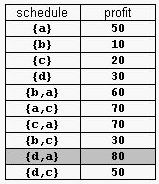poj 1456 Supermarket
2016-01-26 14:04
232 查看
| Language: Default Supermarket
A supermarket has a set Prod of products on sale. It earns a profit px for each product x∈Prod sold by a deadline dx that is measured as an integral number of time units starting from the moment the sale begins. Each product takes precisely one unit of time for being sold. A selling schedule is an ordered subset of products Sell ≤ Prod such that the selling of each product x∈Sell, according to the ordering of Sell, completes before the deadline dx or just when dx expires. The profit of the selling schedule is Profit(Sell)=Σx∈Sellpx. An optimal selling schedule is a schedule with a maximum profit. For example, consider the products Prod={a,b,c,d} with (pa,da)=(50,2), (pb,db)=(10,1), (pc,dc)=(20,2), and (pd,dd)=(30,1). The possible selling schedules are listed in table 1. For instance, the schedule Sell={d,a} shows that the selling of product d starts at time 0 and ends at time 1, while the selling of product a starts at time 1 and ends at time 2. Each of these products is sold by its deadline. Sell is the optimal schedule and its profit is 80.  Write a program that reads sets of products from an input text file and computes the profit of an optimal selling schedule for each set of products. Input A set of products starts with an integer 0 <= n <= 10000, which is the number of products in the set, and continues with n pairs pi di of integers, 1 <= pi <= 10000 and 1 <= di <= 10000, that designate the profit and the selling deadline of the i-th product. White spaces can occur freely in input. Input data terminate with an end of file and are guaranteed correct. Output For each set of products, the program prints on the standard output the profit of an optimal selling schedule for the set. Each result is printed from the beginning of a separate line. Sample Input 4 50 2 10 1 20 2 30 1 7 20 1 2 1 10 3 100 2 8 2 5 20 50 10 Sample Output 80 185 Hint The sample input contains two product sets. The first set encodes the products from table 1. The second set is for 7 products. The profit of an optimal schedule for these products is 185. 这题我用了贪心; 首先按利润进行从高到低排序; 然后一个个安排时间; 优先放在截止日; 如果已经被占,就向前挪一天,直到下限为止; #include<iostream>
#include<string>
#include<algorithm>
#include<cmath>
#include<cstdio>
using namespace std;
struct product
{
int profit;
int deadline;
};
bool comp(const product a,const product b)
{
return a.profit>b.profit;
}
int main()
{
int n;
product p[10000];
while(scanf("%d",&n)!=EOF)
{
int sum=0;
bool flag[10000]={0};
for(int i=0;i<n;++i)
{
scanf(" %d %d",&p[i].profit,&p[i].deadline);
}
//利润从高到底排序
sort(p,p+n,comp);
for(int i=0;i<n;++i)
{
//优先放在截止日
if(flag[p[i].deadline]==0)
{
sum+=p[i].profit;
flag[p[i].deadline]=1;
}
else{
//向前挪位置
for(int j=p[i].deadline-1;j>=1;--j)
{
if(flag[j]==0)
{
sum+=p[i].profit;
flag[j]=1;
break;
}
}
}
}
printf("%d\n",sum);
}
return 0;
} |
相关文章推荐
- MyCAT常用分片规则之分片枚举 - iVictor - 博客园
- [LeetCode122]Best Time to Buy and Sell Stock II
- js中创建桌面网页快捷方式代码
- Boost 学习之算法篇 is_sorted
- Android聊天实现图文混编(包括gif显示)
- 1、开篇
- hibernate4 二级缓存demo实例
- CSS 备忘
- CI框架 -- 核心文件 之 Common.php
- MySQL中优化常用的查询sql语
- iOS开发 小工具
- 对于UVa12096“集合的集合”的理解
- The Java™ Tutorials — Generics :Generic Methods 泛型方法
- 1015. 德才论 (25)
- 万用表怎么用?
- eclipse中使用git
- Oracle spool 用法小结
- 正则表达式-Java
- 其他位不变,具体位的赋值操作
- header操作cookie
